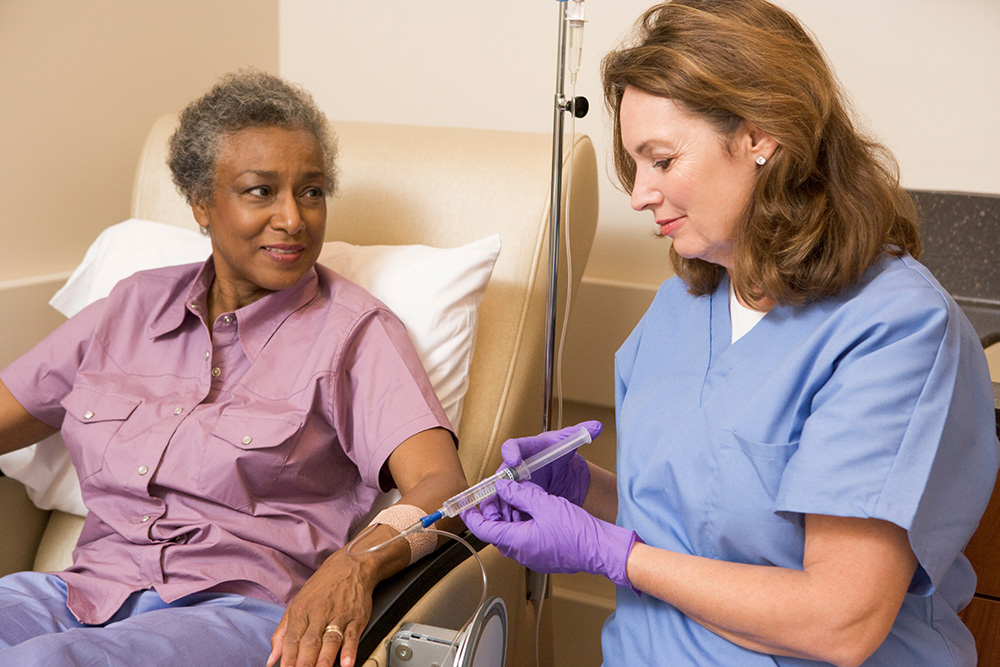
Will at-home cancer treatment options expand?
As recently as the 1980s and 1990s, people with lung cancer frequently needed to be hospitalized to receive some chemotherapies intravenously.
Today, anywhere from 30% to 40% of lung cancer patients seen by Keck Medicine of USC medical oncologist Jorge Nieva, MD, are treated with a pill at home. The reason: “a real revolution in our understanding of the genomic underliers of cancer,” says the lung cancer specialist.
Dr. Nieva, a member of the USC Norris Comprehensive Cancer Center, is concerned about the many patients whose cancer treatments can’t be administered at home — at least not yet.
His solution: a first-of-its-kind clinical trial examining whether a new formulation of atezolizumab — an immunotherapy used to treat certain types of non-small cell lung cancer — can be safely and effectively administered subcutaneously (under the skin) at home by a trained infusion nurse.
Atezolizumab is a monoclonal antibody — a man-made protein — that belongs to a class of medicines that can’t be administered in a pill, because they won’t survive the onslaught of digestive enzymes. These proteins, which provide a foundation for immunotherapy, “are among the most exciting new medicines being used to treat cancer,” says Dr. Nieva.
New technology could improve cancer treatment at home
In the past, such drugs could only be administered intravenously (in a vein). But, with the advent of new technology that improves drug absorption, they can now be delivered under the skin. “That raises the question, ‘Why not administer them at home?’” says Dr. Nieva.
During the COVID-19 pandemic, he began researching ways to make at-home cancer treatments accessible to more patients. His study will enroll up to 37 participants over one to two years. The trial also includes telemedicine visits and wearable electronics for continuous delivery of patient data directly to the medical team, along with a daily digital notepad completed by patients.
The use of telemedicine “exploded” during the spread of COVID-19, and patients appreciate its convenience. “They may not live that far from the doctor’s office, but it’s hard to get around Los Angeles,” says Dr. Nieva, who calls this “a modern house call.”
Study of cancer treatment at home
In the study, participants will don FitBit devices that report on movement, heart rate and other vital signs 24/7. Dr. Nieva’s excitement about the digital tools stems from the increased access to patient data and symptoms, which can support better decision-making.
Having an in-person or a telemedicine conversation with a patient is great, Dr. Nieva adds. “But having a conversation with objective data is even better.”
With other drugs already being successfully administered subcutaneously at home for patients with a variety of conditions, Dr. Nieva is optimistic this treatment model will work for patients with non-small cell lung cancer. Other cancers also may benefit from findings that support under-the-skin drug administration, including small-cell lung cancer, hepatocellular cancer, bladder cancer and melanoma.
With cancer medications getting safer, more effective and easier to administer, “we’re going to see a growth in at-home care, which is where the future of cancer care is headed,” Dr. Nieva says. “I can even envision these medications being self-administered.”
To achieve that reality, he is advocating for elimination of regulatory or financial roadblocks.
Telemedicine visits weren’t approved for Medicare reimbursement until 2020. “It only took a simple change in how Medicare handles telemedicine for it to take off,” says Dr. Nieva. “The future should be guided by rational laws that make at-home care easier.”
Topics
